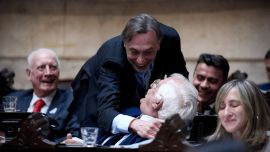April is the cruellest month according to T.S. Eliot and the New England economist Dr Hale sees no immediate reason to disagree with his compatriot in the early days of the month. He writes:
“It suddenly occurred to me, on the day, that this year Easter Sunday fell on April Fool’s Day and since I have the very clear memory that convertibility was launched on the April Fool’s Day of 1991 (indeed my obsession with the Argentine economy dates from those times), I started asking myself what this year’s April Fool might be down your end. One obvious candidate could be household gas bills shooting up by as much as 40 percent from that day, yet that is no hoax but rather an example of ‘the cruellest month.’ Last weekend I was also reading about government plans to place INDEC statistics bureau under a National Statistical Information Council (CNIE in its Spanish acronym) and that would be a much better candidate for pulling the national leg should it prove to be the thin end of the wedge for doctoring data and fudging figures once more. What can you tell me about that?
“But the big picture for me continues to centre on commerce – both internationally with a global trade war looming and domestically with Argentina’s stagnant exports. As we’ve already discussed, the Thirties were not doomed to depression by the Black Tuesday of 1929 (stock market crashes come and go as we are also seeing in these days) but by the Smoot-Hawley tariffs of 1930 destroying two-thirds of world trade in just three years – Donald Trump’s confrontation with China thus worries me deeply. As for Argentina, the debt time-bomb which was your main theme last week would hardly matter if exports were accelerating to close the gap in the balance of payments – without such earnings the country becomes dependent on mostly speculative capital inflows to offset the twin deficits and hence more vulnerable to money market panics at home or abroad. Nor am I convinced that Central Bank reserves (which have trebled since the Kirchnerite inheritance but are now being eroded to keep the dollar down) suffice against the current account shortfalls.”
My reply:
“After fully eight years of tampering by the notorious Guillermo Moreno, it is easy to be paranoid about any outside intervention in the statistics but I would locate the motives elsewhere – which does not make this move any less of a slippery slope towards the fabrication of feelgood figures. The timing does not aid the cynic – the virtual euphoria with which President Mauricio Macri announced just before Easter the descent of poverty from a third to a quarter of the population would suggest that he has no axe to grind with the INDEC statisticians. And Finance Minister Luis Caputo was at pains to point out that all last year’s economic indicators were positive for the first time in a century when appearing in Congress in midweek to explain his offshore interests (Argentina’s 2017 performance was not actually the question – concentrate, Minister Caputo, concentrate!). If the government did want to fiddle the figures, it could do so very easily without changing any institutional architecture – thus the suspicions invited by last year’s official growth rate of 2.9 percent (just below the three percent triggering multi-billion payments on growth-linked bonds) are entirely legitimate in my view, especially when the hasty acquittal of Moreno from any charges of statistical manipulation was also needed.
“My own feeling is that Macri is mostly wearing his G20 cap in contemplating this INDEC shake-up – in other words, this forms part of Macri’s drive to join the OECD (Organisation for Economic Co-operation and Development) by reshaping the statistics bureau according to its criteria (without sharing the traditions of most OECD countries). Nor can it be denied that there is room for improvement in INDEC, even after having been revamped from the Kirchnerite travesty. But the CNIE (manned by seven officials, all from the Executive Branch) is not a mere supervisory body since it is to have the power to remove the INDEC helm with a two-thirds vote – the potential for politicising statistics at any time and under any government would thus be fully there.
“Interesting that you attach paramount importance to trade because in the past week more than one person has singled out the commercial deficit (especially export weakness) to me as the key problem. They include the retired Philip Morris economist D.G.B. Parsons, who might lay claim to being the unofficial economic voice of the Anglo-Argentine community and whom I happened to hear at last Tuesday’s Society of British Engineers of the River Plate monthly luncheon. He is less worried about the fiscal deficit, which he views as largely self-correcting in the next few years with generally falling inflation and hence interest rates. But exports need a major boost to reach US$100 billion by the year 2020 – here he looks primarily to agriculture (despite the drought) but also urges broadening the product mix with such niches as shale and lithium. Yet whatever the product mix, such an export drive would be hamstrung by the current overvalued peso whose reversal along with various other competitive disadvantages thus becomes a sine qua non.
“At the same venue 13 months ago Parsons forecast a 2017 growth rate of 3.5 percent, 20 percent inflation and a dollar worth 25 pesos at the end of the year when the respective official figures were 2.9 percent growth (see the doubts expressed three paragraphs above), 25 percent inflation and a 25-peso greenback. The main results of the gaps between forecast and reality were more inflation and (far more dangerously) an overvalued peso. To correct this, he forecasts a 30-peso dollar by the end of the year while repeating his 2017 target of 20 percent inflation for this year – this is to be achieved by making incomes policy and wage restraint the anchor against inflation via respecting the official guideline of a 15 percent increase, thus implying a real wage cut of five percent in favour of exports and investment. Should the dollar continue to be the anchor against inflation in a country with powerful trade unions, Parsons admits the likely incompatibility of his forecasts – the key to success then becomes “pass through” (i.e. the absorption of the exchange rate by prices). He forecasts a steady three percent growth (or will it be 2.9 percent again?) for both this year and next while 2019 inflation will be 10-15 percent and the dollar is to enter 2020 at 40 pesos per unit.”





















Comments